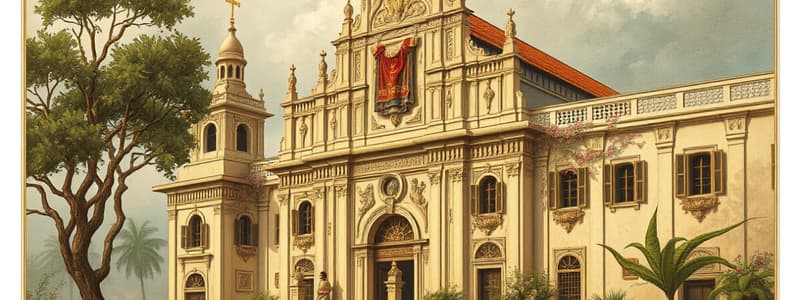Podcast
Questions and Answers
Artists during the Japanese Period primarily focused on themes of peace and harmony.
Artists during the Japanese Period primarily focused on themes of peace and harmony.
False (B)
Diosdado M. Lorenzo's painting, 'Rape and Massacre in Ermita', depicts events from the Battle of Manila in 1945.
Diosdado M. Lorenzo's painting, 'Rape and Massacre in Ermita', depicts events from the Battle of Manila in 1945.
True (A)
'Doomed Family' shows a Japanese soldier rescuing a Filipino family from harm.
'Doomed Family' shows a Japanese soldier rescuing a Filipino family from harm.
False (B)
Contemporary art is classified as art created by artists who are currently alive.
Contemporary art is classified as art created by artists who are currently alive.
The Japanese built public works such as roads and government buildings during their occupation of the Philippines.
The Japanese built public works such as roads and government buildings during their occupation of the Philippines.
GOMBURZA refers to a single Filipino priest executed for his role in the 1872 Cavite mutiny.
GOMBURZA refers to a single Filipino priest executed for his role in the 1872 Cavite mutiny.
The Paoay Church is also known as the Iglesia de San Agustín de Paoay.
The Paoay Church is also known as the Iglesia de San Agustín de Paoay.
Santos, or religious statues, were primarily made of marble during the Spanish Period.
Santos, or religious statues, were primarily made of marble during the Spanish Period.
The execution of GOMBURZA occurred in Bagumbayan, Philippines.
The execution of GOMBURZA occurred in Bagumbayan, Philippines.
Free-standing sculptures and reliefs were common during the American period in the Philippines.
Free-standing sculptures and reliefs were common during the American period in the Philippines.
Flashcards
GOMBURZA
GOMBURZA
Three Filipino priests executed in 1872 for alleged subversion.
SANTOS
SANTOS
Religious statues in Catholicism, carved to represent saints.
San Agustin (Paoay Church)
San Agustin (Paoay Church)
A notable Roman Catholic church in Paoay, famous for baroque architecture.
Oblation
Oblation
Signup and view all the flashcards
Women Working in a Rice Field
Women Working in a Rice Field
Signup and view all the flashcards
ANTING-ANTING
ANTING-ANTING
Signup and view all the flashcards
BULOL
BULOL
Signup and view all the flashcards
Bahay Kubo
Bahay Kubo
Signup and view all the flashcards
Doomed Family
Doomed Family
Signup and view all the flashcards
Contemporary Art
Contemporary Art
Signup and view all the flashcards
Study Notes
Spanish Period
- GOMBURZA refers to three Filipino priests: Mariano Gomes, Jose Burgos, and Jacinto Zamora, executed on February 17, 1872, for alleged subversion after the Cavite mutiny.
- SANTOS are religious statues in Catholic traditions, typically carved from wood, representing saints and used in rituals.
- SAN AGUSTIN, known as the Paoay Church, is a notable Roman Catholic church in Paoay, Ilocos Norte, famous for its baroque architecture.
American Period
- Artists explored landscapes, portraits, genre scenes, and still life; sculptures included free-standing works and public reliefs.
- Urban planning became central, resulting in parks, civic buildings, education facilities, and residential structures.
- "Women Working in a Rice Field," painted by Fabian de la Rosa in 1902, illustrates Filipino women's labor in rice planting.
- The Oblation, a concrete statue by Guillermo Tolentino, symbolizes the University of the Philippines, representing openness to knowledge and change.
Japanese Period
- During the Japanese occupation, artworks depicted themes of war and daily life, often merging Filipino and Japanese cultural elements.
- Public infrastructure projects included roads and government buildings under Japanese oversight.
- "Ermita," a painting by Diosdado M. Lorenzo, reflects the tragic events during the Battle of Manila (1945) amidst WWII.
- "Doomed Family" (1945) by Dominador Castaneda powerfully depicts a family's suffering under Japanese abuse, with imagery of violence and helplessness.
Contemporary Art
- Contemporary art encompasses works by living artists today, exemplified by Victorio Edades's "Man on the Stairs" and Hernando Ruiz Ocampo's "The Contrast" (1960).
- Representations in contemporary art show men as symbols of bravery and women as embodiments of beauty and fertility.
Pre-Conquest
- ANTING-ANTING, or agimat, symbolizes an amulet believed to endow wearers with supernatural strength.
- BULOL, or Ifugao rice god figurines, are carved representations to which anito spirits are said to inhabit, commonly made from narra wood.
- BAHAY KUBO, or nipa hut, is a traditional Filipino dwelling made of bamboo and nipa palm, representing indigenous housing culture.
General Overview
- Philippine art history spans various periods, influenced by colonialism and local culture, resulting in diverse artistic expressions across paintings, sculptures, and architecture.
Studying That Suits You
Use AI to generate personalized quizzes and flashcards to suit your learning preferences.




